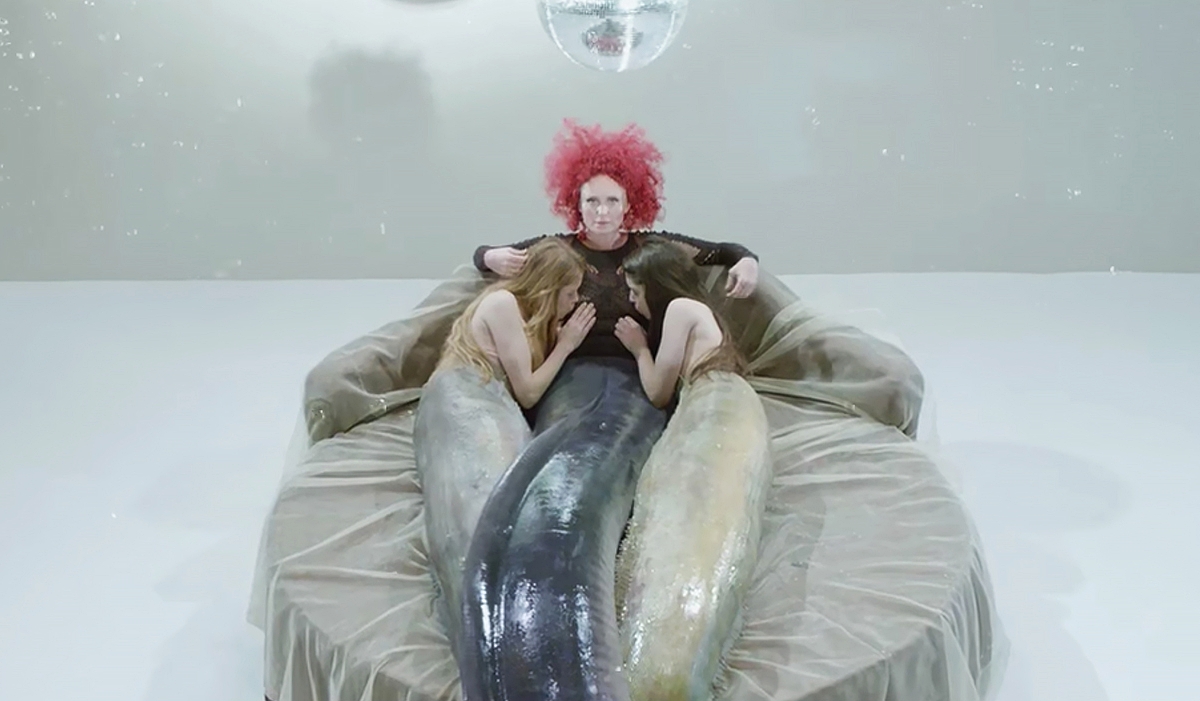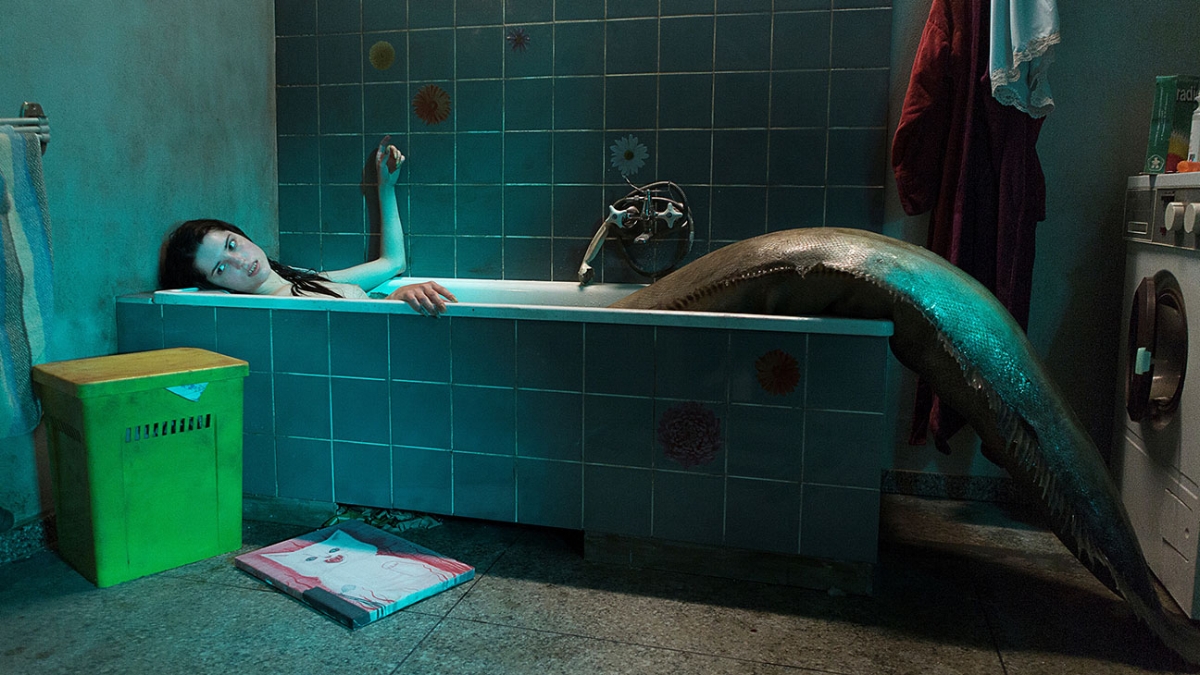
The Lure
Release Date: December 25th, 2015 (in Poland), February 1st, 2017 (in North America)
Running Time: 92 minutes
Directed by: Agnieszka Smoczyńska
Written by: Robert Bolesto
Starring: Michalina Olszańska, Marta Mazurek, Kinga Pries, Jakub Gierszał, Andrzej Konopka, Zygmunt Malanowicz, Magdalena Cielecka, Katarzyna Herman, Marcin Kowalczyk
This Polish feature—director Agnieszka Smoczyńska's debut—has all the makings of a cult film. It's a comedy/horror/fantasy musical about a pair of mermaid sisters who come ashore to "vacation" in Warsaw. Postmodern in its amalgamation of genres and styles, The Lure draws from influences such as 1980s new wave music and Hans Christian Andersen's fairy tale The Little Mermaid, which Smoczyńska has said it's a contemporary retelling of.
The movie addresses feminist issues in inventive fashion, which is admirable even if these aspects are sometimes undermined by aesthetic showiness. An eerie coming-of-age story, it explores the emerging sexuality of teenaged girls/young women by way of the mermaid analogy. Freaky and offbeat, it's full of quirky characters and a fair amount of (female) nudity, sex, and body-horror.
The Lure gains points for originality and sheer weirdness, and for the seamless integration of its vibrant rock opera/art-pop musical numbers into its stylized glam-punk, fantasy universe. The original soundtrack composed by sisters Barbara and Zuzanna Wronská (of Polish indie band Ballady i Romanse, who also appear in the film as themselves) is perhaps the film's strongest asset in contributing to its stylistic allure. Most of the songs are skillfully sung by the actors themselves.
The story opens with the mermaids, named Golden (Michalina Olszańska) and Silver (Marta Mazurek), approaching a trio of musicians partying on a beach one evening. The band—called "Figs 'n Dates"—is comprised of a woman singer (Kinga Pries) and two male instrumentalists: a drummer (Andrzej Konopka) and a young guitar player named Mietek (Jakub Gierszał). The band takes the mermaids to the burlesque, cabaret-style nightclub they perform at, presenting them to its aging owner Kierownik (Zygmunt Malanowicz) who embodies the sleazy qualities of a small-time showbiz manager. He remarks that the two sisters smell like fish, but this no longer bothers him after they're revealed to be mermaids. The girls respond in giggling amusement to his curiosity.
The Lure's mermaid sisters (L-R): Golden (Michalina Olszańska) and Silver (Marta Mazurek) (2015) - Image via janusfilms.com (2017)
When out of water, the young mermaids' lower halves transform into human legs, but when water touches them, their fishtails return. The sisters make no effort to conceal their mermaid identities, and the band, club owner, and patrons all accept them with a measured response of wonder. They become a novelty act at the club (called "The Lure"), seducing audiences with their haunting voices and freakshow appeal. They sing, dance, perform striptease, and climb into a giant fishbowl to transform from women into mermaids onstage. Their sex appeal—to men and women alike—seems more so based on their appearance as young females than on them being mermaids. It's like the fact that they're mermaids is just an enhancing, secondary exotic feature to their main assets of youth and physical feminine beauty.
The movie immediately establishes some parameters of its bizarre world, while leaving other details unexplained. It's never made clear how the rules of mermaid metamorphosis work. For example, a few drops of water on the mermaids' bodies cause their legs to change, but it's not explained if there's a timeline for how long the girls can remain in human form before needing to mutate back into fishtailed women. Sometimes they appear to function fine with legs for long durations while at other times it seems they become weak and sick if away from water for a short period. The girls can and do eat regular human food without issue, but also feast on human flesh—particularly tearing out and eating hearts and larynxes. But the organ-eating seems less a need or compulsion and more a choice. Also, the sisters can communicate telepathically with each other.
Silver falls in love with Mietek, who engages her only to a limited degree. He receives her sexual advances, but not while also admitting to her that while he finds her intriguing, he'll ultimately never be able to regard her as a real woman as much as an animal. Meanwhile, Golden meets Triton, a fellow sea creature living on the land who's cut off his horns to pass more easily as human. He cautions that should her sister fall in love with a human who marries someone else, then Silver will turn into sea foam. Furthermore, Triton warns, if Silver has her fishtail surgically replaced with a pair of human legs, she'll lose her singing voice. Golden tells this to Silver who dismisses it all as myth, and continues to pursue Mietek, thinking she can make him fall in love with her.
Mermaid sisters Golden and Silver mimic breastfeeding in their onstage act in The Lure (2015) - Image via unrtd.co (2017)
While it seems the mermaid sisters retain regular human breasts at all times, their vaginas are slits midway down their massive fishtails. But when in leg-form they have no genitals—only smooth, barbie doll-like skin covering where their crevaces should be. Hence Silver's growing obsession with replacing her mermaid tail with a human lower half, to be able to consummate her desire for Mietek. At one point she tells a male character, "I'll be getting real legs and a pussy".
The film attempts to dissect the myths and puzzles of female sexuality, presenting allegorical meaning that is enigmatic in its intent. In many respects it plays as an indictment of objectification and glamourization of women, sexual exploitation, and misogyny, yet it also portrays the mermaid sisters as flesh-eating monsters by nature, illustrated with innuendo of succubi and siren mythology. And there's an analogical implication of the mermaids being immigrants (they say they are just visiting Poland on their way to America) in the sex trade, objectified by the male club owner and others. As half-fish women they're between worlds, belonging neither entirely to the sea nor land. Although, the film tells us they can return to the sea anytime they want, and they seem to be enjoying themselves throughout most of the story. But they are painted as objects of innocence, beauty, and youth as much as they are as amoral, primal savages—at times making dolphin-like whistle noises, bestial shrieks, and gutteral growls—and growing sharp teeth when about to prey on a man.
There are numerous inexplicable details in the sometimes incoherent storyline—the whole story itself is inexplicable. Embellishing some plot nuances might've increased the work's moral and philosophical resonance, elevating the important issues that it raises rather than just skimming the surface of them as it does. Nonetheless, the narrative shortcomings are forgivable since it's understood to be a largely metaphorical work, and an exercise in style and atmosphere more than soundness of story and believability. And it succeeds in its wildly unique vision and design, displaying a captivating, whimsical universe that buzzes with vitality.
The Lure (2015) features numerous outlandish and entertaining musical numbers – Image via wbur.com (2017)
SPOILER ALERT—DO NOT READ AHEAD IF YOU HAVEN'T SEEN THE FILM AND DO NOT WANT TO KNOW ABOUT SOME KEY DETAILS
As a feminist parable, The Lure flirts with themes of sisterhood within patriarchy, sexism, gender relations, and female body image/body shame—in show business, and society at large. In this respect, questions are provoked by the tale's ending. As foreshadowed earlier in the film, in order to gain the affections of Mietek, Silver indeed gets her mermaid fishtail surgically removed and replaced with "real legs and a pussy". The creepy operation scene shows Silver lying fully conscious while her bottom half is sawed off. A human woman lies on a bed next to her while her bottom half is sawed off and swapped for Silver's (it's never explained why the woman volunteered to become a mermaid, and what happens to her afterward). The surgery is successful and for a moment it seems Silver might win Mietek over, but he spurns her after being disgusted by the bloody stitch scars on her naked body. This perhaps symbolizes the squeamishness and/or repulsion that some men have of women's period blood, and furthers the film's feminist undertones. The suggestion is that women inhabit an impossible paradox when striving to make themselves attractive to men—they're glorified as otherworldly objects of fantasy, then dismissed as unappealing if revealed to possess the natural, biological characteristics of normal people.
So Mietek goes on to fall in love with, get engaged to, and eventually marry another woman. As Triton predicted, Silver loses her voice after the surgery, and the mermaids' partnership with the band and cabaret falls apart. They all attend Mietek's wedding ceremony, with Silver now distant and melancholy. Golden warns her sister that she must eat Mietek before sunrise so as to overturn Triton's prophecy that Silver will turn into sea foam since her love has indeed married another. At the end of the oceanside wedding reception, Silver approaches Mietek and the two slow-dance together as Golden stands nearby, prompting her sister to eat him. Silver grows her sharp teeth and is about to bite Mietek's neck, but at the last minute gives up, smiles sadly, and tenderly embraces him at the moment of daybreak. The sun rises, and he finds himself suddenly covered in foam. Golden, enraged at the death of her sister, kills Mietek anyway, attacking him and ripping out his larynx in front of the wedding attendees. She crawls into the sea, shrieking, and swims away.
I initially thought the story would've had a more powerful message had Silver eaten Mietek, regained her fishtail, retrieved her true mermaid self, and returned to her world of the sea rather than sacrificing herself to the man who shunned her, leaving her sister alone. This might've been a more righteous and uplifting end, rather than concluding as a tragedy. Silver succumbs to her own naivety, transforming her body to gain the affections of and please a human male, even though he rejects her. But on second thought, it's an effective ending nonetheless, implying that Silver is ultimately benevolent and not evil. She martyrs herself for the higher cause of love, for wanting to be loved and accepted as normal rather than regarded as a mystifying, sexualized Other. Having Golden kill the male character signifies the duality of how women are often thought of and portrayed in society at large—either as delicate objects of fragility, beauty, and virginal innocence, or as misandristic, man-eating demonesses.
Smoczyńska's upcoming second feature is reportedly entitled Deranged, a science fiction opera inspired by David Bowie's music. After the outlandish and imaginative qualities of The Lure, she's certainly a filmmaker I'll be keeping an eye on.
Rating (out of 5): ★★★½
• Nik Dobrinsky / Boy Drinks Ink
May 11th, 2017
The Lure (2015) – Image via hollywoodreporter.com / Courtesy of Sundance Institute (2017)







